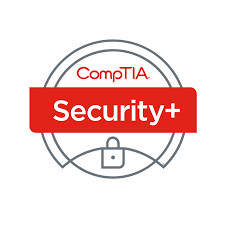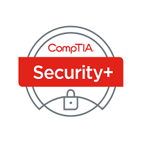IT17B20: COMPTIA SECURITY+ (SF)

COMPTIA SECURITY+ (SF)
Course Duration
Mode of Assessment
Students will be required to complete an assessment during class. There are 2 assessment modes in this module:
- Written Assessment
- Case Study
Who Should Attend
- Security Administrator
- Systems Administrator
- Helpdesk Manager / Analyst
- Network / Cloud Engineer
- Security Engineer / Analyst
- DevOps / Software Developer
- IT Auditors
- IT Project Manager
What's In It for Me
- Focusing on more threats, attacks, and vulnerabilities on the Internet from newer custom devices that must be mitigated, such as IoT and embedded devices, newer DDoS attacks, and social engineering attacks based on current events.
- Includes coverage of enterprise environments and reliance on the cloud, which is growing quickly as organizations transition to hybrid networks.
- Expanded to focus on administering identity, access management, PKI, basic cryptography, wireless, and end-to-end security.
- Covering organizational security assessment and incident response procedures, such as basic threat detection, risk mitigation techniques, security controls, and basic digital forensics.
- Expanded to support organizational risk management and compliance to regulations, such as PCI-DSS, SOX, HIPAA, GDPR, FISMA, NIST, and CCPA.
- Expanded to focus on administering identity, access management, PKI, basic cryptography, wireless, and end-to-end security.
Course Overview
CompTIA's Security+ certification is a foundation-level certificate designed for IT administrators with two years' experience whose job role is focused on system security.
CompTIA Security+ is the first security certification IT professionals should earn. It establishes the core knowledge required of any cybersecurity role and provides a springboard to intermediate-level cybersecurity jobs. Security+ incorporates best practices in hands-on troubleshooting to ensure security professionals have practical security problem-solving skills. Cybersecurity professionals with Security+ know how to address security incidents—not just identify them.
Security+ is compliant with ISO 17024 standards and approved by the US DoD to meet directive 8140/8570.01-M requirements. Regulators and government rely on ANSI accreditation because it provides confidence and trust in the outputs of an accredited program.
Course Schedule
Next available schedule
Course Objectives
Upon completing the course, students will be able to:
- Compare security roles and security controls
- Explain threat actors and threat intelligence
- Perform security assessments and identify social engineering attacks and malware types
- Summarize basic cryptographic concepts and implement public key infrastructure
- Implement authentication controls
- Implement identity and account management controls
- Implement secure network designs, network security appliances, and secure network protocols
- Implement host, embedded/Internet of Things, and mobile security solutions
- Implement secure cloud solutions
- Explain data privacy and protection concepts
- Perform incident response and digital forensics
- Summarize risk management concepts and implement cybersecurity resilience
- Explain physical security
Pre-requisites
To ensure your success in this course, you should have basic Windows and Linux administrator skills and the ability to implement fundamental networking appliances and IP addressing concepts. CompTIA A+ and Network+ certifications, or equivalent knowledge, and six to nine months' experience in networking, including configuring security parameters, are strongly recommended.
It is recommended that you have prior formal trainings in the following:
- CompTIA A+
- CompTIA Network+
Hardware & Software
This course will be conducted as a Virtual Live Class (VLC) via Zoom platform. Participants must own a zoom account and have a laptop or a desktop with “Zoom Client for Meetings” installed. This can be downloaded from https://zoom.us/download.
|
System Requirement |
|
Must Have: Please ensure that your computer or laptop meets the following requirements.
Good to Have:
Not Recommended: |
Course Outline
Lesson 1: Comparing Security Roles and Security Controls
- Compare and contrast information security roles
- Compare and contrast security control and framework types
Lesson 2: Explaining Threat Actors and Threat Intelligence
- Explain threat actor types and attack vectors
- Explain threat intelligence sources
Lesson 3: Performing Security Assessments
- Assess organizational security with network reconnaissance tools.
- Explain security concerns with general vulnerability types.
- Summarize vulnerability scanning techniques.
- Explain penetration testing concepts.
Lesson 4: Identifying Social Engineering and Malware
- Compare and contrast social engineering techniques.
- Analyze indicators of malware-based attacks.
Lesson 5: Summarizing Basic Cryptographic Concepts
- Compare and contrast cryptographic ciphers.
- Summarize cryptographic modes of operation.
- Summarize cryptographic use cases and weaknesses.
- Summarize other cryptographic technologies.
Lesson 6: Implementing Public Key Infrastructure
- Implement certificates and certificate authorities.
- Implement PKI management.
Lesson 7: Implementing Authentication Controls
- Summarize authentication design concepts.
- Implement knowledge-based authentication.
- Implement authentication technologies.
- Summarize biometrics authentication concepts.
Lesson 8: Implementing Identity and Account Management Controls
- Implement identity and account types.
- Implement account policies.
- Implement authorization solutions.
- Explain the importance of personnel policies.
Lesson 9: Implementing Secure Network Designs
- Implement secure network designs.
- Implement secure routing and switching.
- Implement secure wireless infrastructure.
- Implement load balancers.
Lesson 10: Implementing Network Security Appliances
- Implement firewalls and proxy servers.
- Implement network security monitoring.
- Summarize the use of SIEM.
Lesson 11: Implementing Secure Network Protocols
- Implement secure network operations protocols.
- Implement secure application protocols.
- Implement secure remote access protocols.
Lesson 12: Implementing Host Security Solutions
- Implement secure firmware.
- Implement endpoint security.
- Explain embedded system security implications.
Lesson 13: Implementing Secure Mobile Solutions
- Implement mobile device management.
- Implement secure mobile device connections.
Lesson 14: Summarizing Secure Application Concepts
- Analyze indicators of application attacks.
- Analyze indicators of web application attacks.
- Summarize secure coding practices.
- Implement secure script environments.
- Summarize deployment and automation concepts.
Lesson 15: Implementing Secure Cloud Solutions
- Summarize secure cloud and virtualization services.
- Apply cloud security solutions.
- Summarize infrastructure as code concepts.
Lesson 16: Explaining Data Privacy and Protection Concepts
- Explain privacy and data sensitivity concepts.
- Explain privacy and data protection controls.
Lesson 17: Performing Incident Response
- Summarize incident response procedures.
- Utilize appropriate data sources for incident response.
- Apply mitigation controls.
Lesson 18: Explaining Digital Forensics
- Explain key aspects of digital forensics documentation.
- Explain key aspects of digital forensics evidence acquisition.
Lesson 19: Summarizing Risk Management Concepts
- Explain risk management processes and concepts.
- Explain business impact analysis concepts.
Lesson 20: Implementing Cybersecurity Resilience
- Implement redundancy strategies.
- Implement backup strategies.
- Implement cybersecurity resiliency strategies.
Lesson 21: Explaining Physical Security
- Explain the importance of physical site security controls.
- Explain the importance of physical host security controls.
Certificate Obtained and Conferred by
- Certificate of Completion from NTUC LearningHub
Upon meeting at least 75% attendance and passing the assessment(s), participants will receive a Certificate of Completion from NTUC LearningHub.
- Statement of Attainment (SOA) from SkillsFuture Singapore
After passing the assessment(s), participants will receive a SOA from SkillsFuture Singapore, certifying that they have achieved the following Competency Standard(s):
- ICT-DES-3004-1.1 Security Architecture
- External Certification
The participant will be able to attempt the CompTIA Security+ certification exam after attending this course. Upon passing the exam, you will receive the CompTIA Security+ certification. This certification validates that you have the knowledge and skills required to install and configure systems to secure applications, networks, and devices; perform threat analysis and respond with appropriate mitigation techniques; participate in risk mitigation activities; and operate with an awareness of applicable policies, laws, and regulations.
- CompTIA Exam Fee
The course fees do not cover the cost of the CompTIA Security+ (SY0-701) Exam Voucher. Those interested in taking these exams need to purchase their own exam vouchers, which are available for purchase via SY0-701.
CompTIA Security+ voucher: $ 538.37 (inclusive of 9% GST) per voucher
Exam voucher: SY0-701
Exam duration: 90 Mins per Exam
Exam format: Maximum of 90 questions per exam. Multiple choice questions (single and multiple response), drag and drops and performance-based
Passing score: 750 (on a scale of 100-900)
Find out more information about the CompTIA Security+ exams.
You will be awarded with the following digital badge(s) upon passing the official CompTIA Security+ (SY0-701) Exam Voucher:

Additional Details
Medium of Instruction: English
Trainer to trainee ratio: 1:20
Mode of Delivery: Virtual Live Class (VLC) via Zoom or Physical class (F2F)
Courseware: CompTIA Official Digital Courseware and Lab
Price
|
Course Fee and Government Subsidies |
||||||
|
|
Individual Sponsored |
Company Sponsored |
||||
|
Non-SME |
SME |
|||||
|
Before GST |
After GST |
Before GST |
After GST |
Before GST |
After GST |
|
|
Full Course Fee (For Foreigners and those not eligible for subsidies) |
$2,500.00 |
$2,725.00 |
$2,500.00 |
$2,725.00 |
$2,500.00 |
$2,725.00 |
|
For Singapore Citizens aged 39 and below and For all Singapore Permanent Residents (The minimum age for individual sponsored trainees is 21 years) |
$1,250.00 |
$1,475.00 |
$1,250.00 |
$1,475.00 |
$750.00 |
$975.00 |
|
For Singapore Citizens aged 40 years and above |
$750.00 |
$975.00 |
$750.00 |
$975.00 |
$750.00 |
$975.00 |
Funding Eligibility Criteria
|
Individual Sponsored Trainee |
Company Sponsored Trainee |
|
|
Remarks
|
Company Sponsored Trainee |
|
|
SkillsFuture Credit:
PSEA:
|
Absentee Payroll (AP) Funding:
|
Terms & Conditions apply. NTUC LearningHub reserves the right to make changes or improvements to any of the products described in this document without prior notice.
Prices are subject to other LHUB miscellaneous fees.
| Batch ID | Course Period | Course Title | Funding Available |
Duration (Hours) |
Session (Hours) |
Venue | Available Seats |
Online Payment |
|---|
What Others Also Enrolled In

EC-COUNCIL COMPUTER HACKING FORENSIC INVESTIGATOR (CHFI) (SF)
View detail
